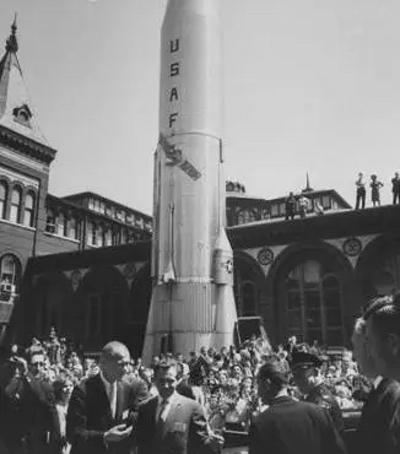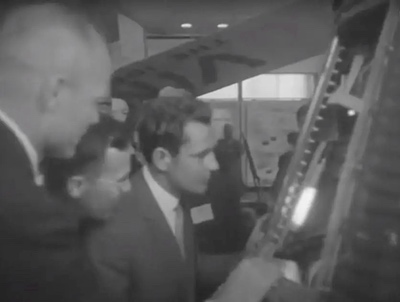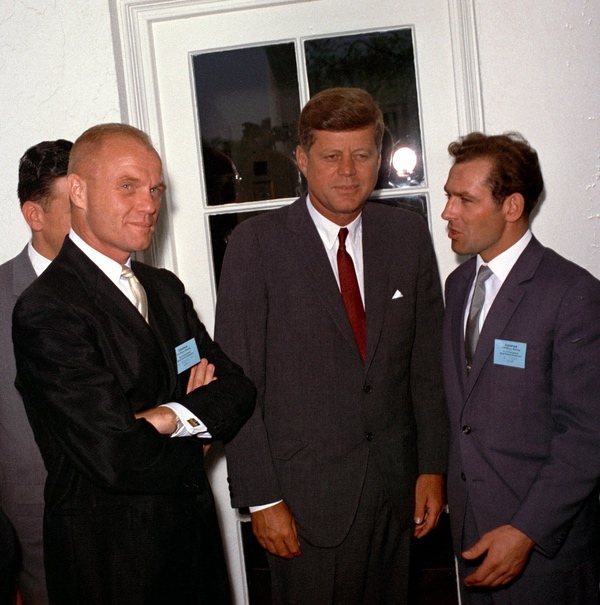Cosmonaut exploitation: the CIA and Gherman Titov’s 1962 visit to the United Statesby Dwayne A. Day
|
| The US government declassified an intriguing memo about the time a Soviet cosmonaut visited the United States in the early 1960s that raises more questions than it answers. |
Gherman Titov was the second human to orbit the Earth, launching aboard Vostok 2 in August 1961, when he was only 25 years old. His flight lasted one day, one hour, and 18 minutes, and he remains the youngest professional astronaut and youngest person to orbit the Earth. Titov, who died in 2000 at the age of 65, never made another flight, his cosmonaut career cut short by the death of Yuri Gagarin in 1968 and the Soviet government’s concern that it could not lose the country’s second cosmonaut.
In 1962, Titov made a widely-publicized and rather lengthy visit to the United States. During that visit, he was asked if his space flight had changed his philosophy. "Sometimes people are saying that God is out there,” Titov replied. “I was looking around attentively all day but I didn’t find anybody there. I saw neither angels nor God.” His statement, which was later misattributed to Yuri Gagarin, was widely publicized both in the East and West, and is the most remembered (or misremembered) aspect of his goodwill trip to the United States.
  Titov viewing an Atlas missile and Mercury spacecraft during his Washington visit. At the time, no pictures of Titov’s rocket or spacecraft had been publicly released. (credit: NASA) |
If it’s Tuesday, this must be New York…
Titov landed in New York on May 1, then traveled to Washington, followed by visits to Baltimore, Seattle, and San Francisco before returning to New York. From New York he made a brief visit to Halifax, Canada, on May 12, then on to the United Kingdom before flying home to the USSR. The young cosmonaut definitely had the stamina for the trip.
In Washington, Titov was escorted by Colonel John Glenn and his wife and also met Alan Shepard. They visited the major monuments as well as Capitol Hill. During a lengthy press conference he talked about his flight, including mentioning that his rocket used six engines. He visited the White House and was greeted by President Kennedy. Glenn also showed Titov both an Atlas rocket and a Mercury capsule.
Nikolai Kamanin, the Soviet Air Force representative to the Soviet space program, accompanied Titov on his American trip and wrote about it in his extensive personal diary, which was later translated in part by noted space historian Asif Siddiqi. “His position in the Soviet space program was like that of Deke Slayton, or maybe George Abbey,” Siddiqi says. “He picked the crews and the cosmonauts were basically terrified of him.”
Kamanin was a good observer and a detailed diarist with a dry sense of humor, as evidenced by his summary of part of the Washington visit:
At 8:45 before breakfast, Titov and Glenn were received by US President John Kennedy. He said that he was glad to welcome Titov and was proud that the American people were welcoming the famous astronaut well. At 13:00, they had lunch at the UN Deputy Secretary-General Johnson in the State Department building (Johnson, Glenn, Titov and [Soviet ambassador] Dobrynin - all with their wives - me and three more people from the State Department). At 14:30, in the same building, they took part in a COSPAR meeting. The Frenchman showed a dead rat, the American - a vomit-covered monkey. More informative were the reports of Parin, Titov, Glenn and the American Matthews. The President of COSPAR Van de Helst, closing the meeting, presented Titov and Glenn with large wooden Dutch shoes. He said: “Mr. Titov, Mr. Glenn, these shoes are made of the same tree, and it would be very good if they always walked together.” Titov got the left shoe, and Glenn got the right one.
In the evening there was a large reception at the Vice President of the USA Lyndon Johnson, who paid us much attention, walked us to our cars and said that he would soon be in Moscow and would be happy to visit Titov. Johnson’s wife said to Tamara: “Look how well and amicably our men converse, they need to meet more often, and then they will certainly agree on everything.” Johnson in the past said a lot of nasty things about the USSR, and now he is apparently preparing the ground for a trip to our country.
Kamanin believed that the visit was highly successful and he thought it went very well—and that Titov proved to be well-suited for the trip, with a witty sense of humor that was sometimes literally lost in translation when the translator left some words out. “The American press and television very widely and objectively covered Titov's stay in the USA,” Kamanin wrote. He added that:
Titov's television appearances were broadcast several times a day and were not interrupted by commercials, which is completely unusual for American television broadcasts. The American authorities were polite, showed Titov respect and attention, but at the same time made efforts to limit his contacts with ordinary people. Nevertheless, mass meetings with Americans took place in Seattle and San Francisco, as well as in the last days of his stay in New York. Numerous warm meetings of Titov and members of our delegation with Americans are clear evidence that the American people want to live in peace and friendship with the Soviet people. Titov’s trip to the United States, formally conducted at the invitation of the International Organization for the Peaceful Exploration of Outer Space (COSPAR) and the UN Secretary General, in the second part of the visit actually turned into mass meetings of the Soviet cosmonaut with American citizens, who, despite the obstacles created by the authorities, expressed their warm and friendly attitude towards Titov and the Soviet Union.
The CIA
A recently declassified memo now adds an interesting question about Titov’s visit to the United States. A week after Titov’s visit, Philip G. Strong, the Deputy Assistant Director for Collection of Scientific Intelligence at the CIA, wrote a memo to Allen Dulles, the Director of Central Intelligence. Strong was informing Dulles of a letter for Dulles to send to NASA Administrator James Webb on “cooperation of NASA During Major Gherman Titov’s Visit to the United States.”
Strong wrote, “When it became certain that the Soviet astronaut, Major Gherman Titov would come to this country to attend COSPAR meetings, the intelligence community worked, through Dr. Charles Mathews, Chief of OSI Space Division, and the CIA Office of Operations, in planning and carrying out the intelligence exploitation. Without the complete and enthusiastic cooperation of NASA this exploitation could not have been carried out and the attached letter expresses our appreciation to Mr. Webb.”
| “Without the complete and enthusiastic cooperation of NASA this exploitation could not have been carried out and the attached letter expresses our appreciation to Mr. Webb.” |
Strong’s memo does not mention what “exploitation” took place, nor what was learned. He also does not mention what NASA’s cooperation involved. At the very least, NASA probably agreed to have all of its personnel who interacted with Titov—obviously including John Glenn—debriefed and discuss anything that Titov may have mentioned to them about his spacecraft and the R-7 rocket that launched him into orbit. Although Titov got to see an Atlas missile and Mercury spacecraft up close, at the time, no photographs of the Vostok or the R-7 rocket had been released, and they would not be for several years. The CIA certainly had other sources of intelligence on the rocket and Titov’s mission, such as intercepted electronic communications, but every bit of information from the cosmonaut could have helped. The CIA may have also asked Glenn to ask specific questions about the flight, although Kamanin never indicated that he thought the Americans were trying to discern specific information. For his part, Kamanin appeared to be particularly interested in whether the Mercury astronauts would have parachutes to escape from their spacecraft, like the Soviets did.
One intriguing aspect of the newly-declassified memo is that it mentions Dr. Charles Matthews as Chief of the Office of Scientific Intelligence Space Division—presumably the same “American Matthews” whom Kamanin found so informative at the COSPAR meeting. Kamanin probably had no idea that Matthews worked for the CIA.
Cooperation between NASA and the intelligence community had taken a major hit in May 1960 when Gary Powers’ U-2 spyplane had been shot down over the Soviet Union. NASA provided the cover story that the plane was owned by the agency and was used for weather research, and when that cover story blew up and it became clear that the aircraft and pilot belonged to the CIA, then NASA administrator, T. Keith Glennan, believed that the incident harmed NASA’s image. When James Webb became NASA administrator in early 1961, he had a much more cordial meeting with the CIA and offered his agency’s cooperation. This later included NASA providing expertise in interpreting data that the intelligence community collected on Soviet rockets and spacecraft—such as Titov’s R-7.
Somewhere, buried in a CIA warehouse, probably next to the Ark of the Covenant, is the CIA file on what the agency learned from Titov during his visit and how. Did Titov get a loose tongue after too many drinks with NASA astronauts? Did he talk in his sleep? Did he say anything interesting, or divulge little that was new or unique or useful? We may never know. What we do know is that behind this friendship visit of a cosmonaut to the United States, the US intelligence community was lurking.
Note: we are now moderating comments. There will be a delay in posting comments and no guarantee that all submitted comments will be posted.
